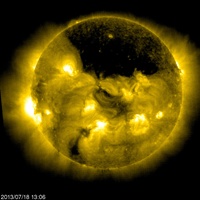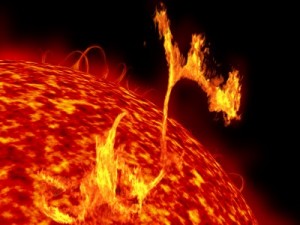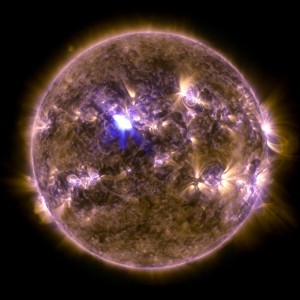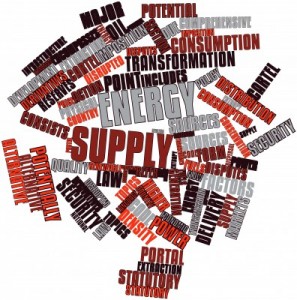
A coronal hole on the sun moving toward the Sun’s North Pole about 400,000 miles across. NASA July 18, 2013.
The Earth is 93 million miles away from the Sun, and this places our planet in the sweet spot. We are not too close to the Sun, and we’re not too far away – we are positioned PERFECTLY to the Sun. Because of our position, we have a plethora of life on Earth unlike any other planet in our solar system. We are lucky ducks.
Solar Changes
When the Sun changes, though, it changes all life on Earth, and whether the changes are good or bad, humans have gotten so used to the ways things are now, change doesn’t come easy.
Affects On Earth
Every 11 years, the Sun’s surface becomes more active with violent eruptions and increased heat. This current solar cycle is reaching its maximum activity in late 2013 and early 2014. This doesn’t mean that the solar cycle is over; this means that over the next few years, the Sun will begin cooling down, and its effects on the Earth will be less threatening as today.
The presence of a huge coronal hole is our signal that the surface of the Sun is turning the corner and beginning to calm down.
From Flares To Holes
Holes in the Sun, known as coronal holes, are currently ramping up toward what is known as solar maximum, currently predicted for late 2013. During this portion of the cycle, the number of coronal holes decreases. During solar max, the magnetic fields on the Sun reverse, and new coronal holes appear near the poles with the opposite magnetic alignment. The coronal holes then increase in size and number, extending farther from the poles as the Sun moves toward solar minimum again. At such times, coronal holes have appeared that are even larger than this one.
The holes are important to our understanding of space weather, as they are the source of a high-speed wind of solar particles that streams off the Sun some three times faster than the slower wind elsewhere. While it’s unclear what causes coronal holes, they correlate to areas on the Sun where magnetic fields soar up and away, failing to loop back down to the surface as they do elsewhere.
EMPs, or electromagnetic pulses, are high energy explosions of electromagnetic radiation on the Sun, much like nuclear explosions, and these explosions can send out huge solar flares wiping out communication systems and modern electronics on the Earth.
Coronal mass ejections (CMEs), commonly known as solar flares, are massive bursts of solar wind and magnetic fields rising above the Sun’s surface and being released into space. Most CMEs originate from very active regions on the Sun’s surface.

A solar flare, or CME, exploding off the surface of the Sun.
Not Out Of The Woods Yet
Before the Sun cools down, it will reach its peak of increasing heat and surface eruptions. This impacts the Earth in many ways.
As 2013 closes and we begin 2014, we will continue to experience strange weather patterns, violent storms, and increases in volcanoes and earthquakes.
Remember that the Earth is responding to the dominant influences of the Sun, and as long as the Sun is fired up – we’ll stay fired up.





